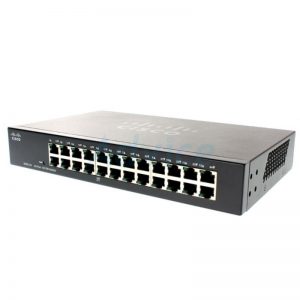The Cisco ® SPS service provider switches deliver cost-effective Metro Ethernet access solutions. These products are optimized for multitenant units (MTUs) and multidwelling units (MDUs) in which the service provider delivers triple-play (VoIP, video, and data) services to multiple businesses or homes in close proximity.
The Cisco SPS2024 24-Port 10/100/1000 Gigabit SP Switch (Figure 1) is ideal for environments in which security and uptime are important. It offers 24 Gigabit copper ports and 2 shared Small Form-Factor Pluggable (SFP) modules for optional optical interfaces for connecting to the core network.
The Cisco SPS switches facilitate the delivery of multiple services over a Layer 2 network with support for Q-in-Q stacking. This feature allows customer VLANs to be kept separate across the service provider backbone. Also, for efficient delivery of multicast traffic (such as video) to multiple customers, these switches provide support for a variation of Multicast VLAN Registration (MVR).
Network security is a primary concern for service providers, and the SPS switches deliver a number of advanced features that alleviate this concern. Support for dynamic Address Resolution Protocol (ARP) inspection eliminates the man-in-the-middle attack. IP Source Guard prevents a subscriber (or malicious user) from using an IP address not assigned to them. DHCP Guard keeps rogue devices from behaving like Dynamic Host Configuration Protocol (DHCP) servers. Spanning Tree Protocol (STP) Root Guard prevents a rogue spanning tree device from advertising that it should be the root bridge, thereby having the spanning tree network compromised by an outside device. Unauthorized access to the network is protected through 802.1X port and multisession authentication and MAC filtering/port security. The 802.1X standard requires clients to authenticate themselves before the port will pass data for them. An additional security feature is access control lists (ACLs), which restrict network use to certain users, groups, or applications. The SPS switches also secure management traffic, with support for Secure Shell (SSH) Protocol, SSL, and Simple Network Management Protocol (SNMP) v3.
The management capabilities of the SPS switches include support for DHCP option 82, allowing for assignment of IP addresses to subscribers based on where they connect to the network. Management can be performed through a GUI or command-line interface (CLI). The switches also support SNMP for management from a network management station.
Features
• Twenty-four 10/100/1000 switched RJ-45 ports that deliver up to 2000 Mbps of throughput per port
• Two shared mini Gigabit Interface Converter (mini-GBIC) slots for fiber and copper Gigabit Ethernet expansion
• 48-Gbps nonblocking, store-and-forward switching mechanism
• Simplified QoS management enabled by advanced queuing techniques using 802.1p, Differentiated Services (DiffServ), or type of service (ToS) traffic prioritization
• Configuration and monitoring from a console port with the CLI or from a standard web browser with WebView management
• Secure remote management of the switch via SSH and SSL secure channel network protocols
• 802.1Q-based VLANs, enabling segmentation of networks for improved performance and security
• Stacking Q-in-Q VLANs, allowing customer VLANs to transparently cross a service provider network and isolate traffic among customers
• Private VLAN Edge (PVE) for simplified network isolation of guest connections or autonomous networks
• Automatic configuration of VLANs across multiple switches through Generic VLAN Registration Protocol (GVRP) and Generic Attribute Registration Protocol (GARP)
• Automatic medium dependent interface (MDI) and MDI crossover (MDI-X) detection
Table 1 gives the specifications for the Cisco SPS2024 switch.





There are no reviews yet.